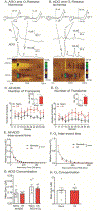Caffeine Modulates Spontaneous Adenosine and Oxygen Changes during Ischemia and Reperfusion
- PMID: 30252436
- PMCID: PMC7003050
- DOI: 10.1021/acschemneuro.8b00251
Caffeine Modulates Spontaneous Adenosine and Oxygen Changes during Ischemia and Reperfusion
Abstract
Adenosine is an endogenous neuroprotectant that modulates vasodilation in the central nervous system. Oxygen changes occur when there is an increase in local cerebral blood flow and thus are a measure of vasodilation. Transient oxygen events following rapid adenosine events have been recently discovered, but the relationship between adenosine and blood flow change during ischemia/reperfusion (I/R) has not been characterized. Caffeine is a nonselective adenosine receptor antagonist that can modulate the effects of adenosine in the brain, but how it affects adenosine and oxygen levels during I/R is also unknown. In this study, extracellular changes in adenosine and oxygen were simultaneously monitored using fast-scan cyclic voltammetry during bilateral common carotid artery occlusion (BCCAO) and the effects of a specific A2A antagonist, SCH 442416, or general antagonist, caffeine, were studied. Measurements were made in the caudate-putamen for 1 h of normoxia, followed by 30 min of BCCAO and 30 min of reperfusion. The frequency and number of both adenosine and oxygen transient events significantly increased during I/R. The specific A2A antagonist, SCH 442416 (3 mg/kg, i.p.), eliminated the increase in adenosine and oxygen events caused by I/R. The general adenosine receptor antagonist, caffeine (100 mg/kg, i.p.), decreased the frequency of adenosine and oxygen transient events during I/R. These results demonstrate that, during BCCAO, there are more rapid release events of the neuromodulator adenosine and correlated local oxygen changes, and these rapid, local effects are dampened by caffeine and other A2A antagonists.
Keywords: A2A receptor; Adenosine; BCCAO; FSCV; blood flow; caffeine; fast-scan cyclic voltammetry; in vivo; ischemia/reperfusion injury; oxygen.
Conflict of interest statement
The authors declare no competing financial interests.
Figures






Similar articles
-
Spontaneous, transient adenosine release is not enhanced in the CA1 region of hippocampus during severe ischemia models.J Neurochem. 2021 Dec;159(5):887-900. doi: 10.1111/jnc.15496. Epub 2021 Sep 20. J Neurochem. 2021. PMID: 34453336 Free PMC article.
-
Early changes in transient adenosine during cerebral ischemia and reperfusion injury.PLoS One. 2018 May 25;13(5):e0196932. doi: 10.1371/journal.pone.0196932. eCollection 2018. PLoS One. 2018. PMID: 29799858 Free PMC article.
-
Correlation of transient adenosine release and oxygen changes in the caudate-putamen.J Neurochem. 2017 Jan;140(1):13-23. doi: 10.1111/jnc.13705. Epub 2016 Dec 15. J Neurochem. 2017. PMID: 27314215 Free PMC article.
-
Adenosine A1-A2A receptor heteromers: new targets for caffeine in the brain.Front Biosci. 2008 Jan 1;13:2391-9. doi: 10.2741/2852. Front Biosci. 2008. PMID: 17981720 Review.
-
Do caffeine and more selective adenosine A2A receptor antagonists protect against dopaminergic neurodegeneration in Parkinson's disease?Parkinsonism Relat Disord. 2020 Nov;80 Suppl 1(Suppl 1):S45-S53. doi: 10.1016/j.parkreldis.2020.10.024. Epub 2020 Dec 19. Parkinsonism Relat Disord. 2020. PMID: 33349580 Free PMC article. Review.
Cited by
-
Dual-Channel Electrochemical Measurements Reveal Rapid Adenosine is Localized in Brain Slices.ACS Chem Neurosci. 2022 Feb 16;13(4):477-485. doi: 10.1021/acschemneuro.1c00679. Epub 2022 Jan 25. ACS Chem Neurosci. 2022. PMID: 35077156 Free PMC article.
-
Spontaneous, transient adenosine release is not enhanced in the CA1 region of hippocampus during severe ischemia models.J Neurochem. 2021 Dec;159(5):887-900. doi: 10.1111/jnc.15496. Epub 2021 Sep 20. J Neurochem. 2021. PMID: 34453336 Free PMC article.
-
A1 and A2A Receptors Modulate Spontaneous Adenosine but Not Mechanically Stimulated Adenosine in the Caudate.ACS Chem Neurosci. 2020 Oct 21;11(20):3377-3385. doi: 10.1021/acschemneuro.0c00510. Epub 2020 Oct 7. ACS Chem Neurosci. 2020. PMID: 32976713 Free PMC article.
-
Discovery of Pyridone-Substituted Triazolopyrimidine Dual A2A/A1 AR Antagonists for the Treatment of Ischemic Stroke.ACS Med Chem Lett. 2022 Feb 21;13(3):436-442. doi: 10.1021/acsmedchemlett.1c00599. eCollection 2022 Mar 10. ACS Med Chem Lett. 2022. PMID: 35295085 Free PMC article.
-
Accurate and stable chronic in vivo voltammetry enabled by a replaceable subcutaneous reference electrode.iScience. 2022 Aug 2;25(8):104845. doi: 10.1016/j.isci.2022.104845. eCollection 2022 Aug 19. iScience. 2022. PMID: 35996579 Free PMC article.
References
-
- Heron M Deaths: Leading Causes for 2011. Natl Vital Stat Rep. 2015;64(7):1–96. - PubMed
-
- Heistad DD, Marcus ML, Gourley JK, Busija DW. Effect of adenosine and dipyridamole on cerebral blood flow. Am J Physiol. 1981;240(5):H775–80. - PubMed
-
- Phillis JW. Adenosine in the control of the cerebral circulation. Cerebrovasc Brain Metab Rev. 1989;1(1):26–54. - PubMed
Publication types
MeSH terms
Substances
Grants and funding
LinkOut - more resources
Full Text Sources
Other Literature Sources
Medical
Miscellaneous

